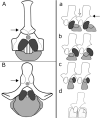Early amphibians evolved distinct vertebrae for habitat invasions
- PMID: 34106947
- PMCID: PMC8189462
- DOI: 10.1371/journal.pone.0251983
Early amphibians evolved distinct vertebrae for habitat invasions
Abstract
Living tetrapods owe their existence to a critical moment 360-340 million years ago when their ancestors walked on land. Vertebrae are central to locomotion, yet systematic testing of correlations between vertebral form and terrestriality and subsequent reinvasions of aquatic habitats is lacking, obscuring our understanding of movement capabilities in early tetrapods. Here, we quantified vertebral shape across a diverse group of Paleozoic amphibians (Temnospondyli) encompassing different habitats and nearly the full range of early tetrapod vertebral shapes. We demonstrate that temnospondyls were likely ancestrally terrestrial and had several early reinvasions of aquatic habitats. We find a greater diversity in temnospondyl vertebrae than previously known. We also overturn long-held hypotheses centered on weight-bearing, showing that neural arch features, including muscle attachment, were plastic across the water-land divide and do not provide a clear signal of habitat preferences. In contrast, intercentra traits were critical, with temnospondyls repeatedly converging on distinct forms in terrestrial and aquatic taxa, with little overlap between. Through our geometric morphometric study, we have been able to document associations between vertebral shape and environmental preferences in Paleozoic tetrapods and to reveal morphological constraints imposed by vertebrae to locomotion, independent of ancestry.
Conflict of interest statement
The authors have declared that no competing interests exist.
Figures





References
-
- Clack JA. Gaining ground: the origin and evolution of tetrapods. Indiana University Press; 2012. 2nd ed.
-
- Buchholtz EA. Vertebral osteology and swimming style in living and fossil whales (Order: Cetacea). Journal of Zoology. 2001;253: 175–190.
-
- Motani R, You H, McGowan C. Eel-like swimming in the earliest ichthyosaurs. Nature. 1996. Jul;382(6589):347–8.
-
- Panchen AL. The axial skeleton of the labyrinthodont Eogyrinus attheyi. Journal of Zoology. 1966;150:199–222.
Publication types
MeSH terms
LinkOut - more resources
Full Text Sources

